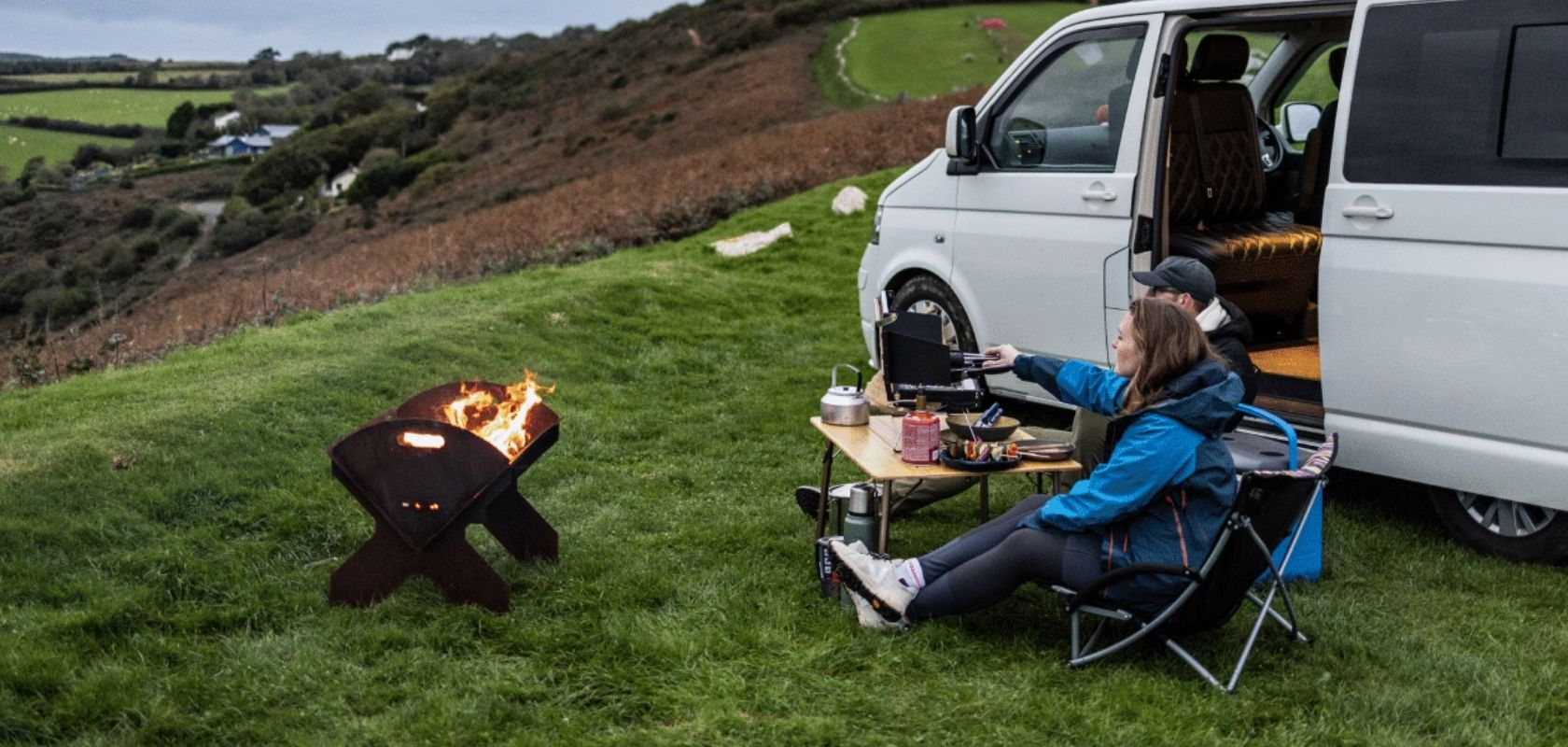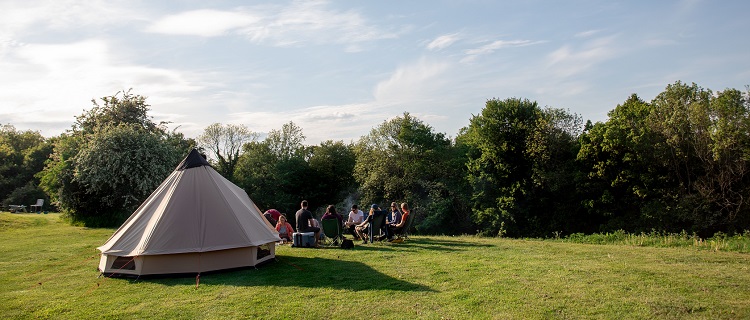Campervan Drive-Away Awnings Guide
We all know campervans are great for helping us explore whilst at the same time remaining self-sufficient. The flexibility to go anywhere the road takes you and have everything you need to cook, relax and enjoy a comfy night’s sleep is all part of their enduring appeal.
But with best will in the world, even the tidiest campers and the biggest vans can feel a little cramped at times. But that needn’t be the case. The extra space afforded by the simple addition of a drive-away awning makes it possible to elevate your campervan experience from great to something approaching luxury, without compromising on flexibility.
What is a Drive-Away Awning?
A drive-away awning is a tent that attaches to the side of your campervan to create an extension. Think of it a bit like adding a detachable conservatory to your travelling home! Made from the same type of weatherproof and hardwearing materials as tents, they are set up in the same way but unlike a freestanding tent, they attach snuggly to the side of your vehicle and have an opening that lets you pass directly from vehicle to awning and vice-versa.
What makes drive-away awnings great is that, once detached, they remain upright as a freestanding tent that does not lose shape or stability. That means you can simply detach it when you want to drive off and use your vehicle to explore further afield for the day, and then reattach it when you return without the hassle of having dismantle your awning and repack everything whilst you’re off exploring.
What are the Benefits of a Drive-Away Awning?
Perhaps you simply need more space or want some extra shelter? Maybe squeezing your long legs under your van’s cramped breakfast table has become an inconvenience you’ve grown (literally!) to live without? The benefits of a drive-away awning to a camping set up will mean different things to different people. But here are some of the top ways they may be able to help enhance your campervan experience:
The Types of Drive-Away Awnings and Vehicles That Can Use Them
Drive-away awnings come in a variety of shapes and sizes and what you choose will ultimately depend on the type of vehicle you have, how you want to use it to best suit your lifestyle, and your budget. Whatever your personal preferences, here are a few things to consider:
Size Matters
If having extra space is your main reason to buy an awning, think carefully about exactly what you need from your awning in terms of size. Awnings come in a variety of sizes, at varying cost, so it’s worth thinking about what you need for both now and for the future trips. Size (as in height) is also important when it comes to fitting, but we’ll cover that shortly.
Privacy
Do you want the awning to be open plan? Just a room for storage? Or do you want it to be able to accommodate a privacy screen or fit an inner bedroom? Different awnings come in different designs, so check what features your awning has and make sure they meet your requirements.
Be Versatile
What you need now might not be what you need in the future. Some drive-away awnings have an option to add a further annexe at a later date, making them versatile and adaptable to changing travelling habits. They’re usually a little more pricey but they could give you more value for money in the long run if you think your travelling circumstances may vary.
Air vs Poles
Most awnings are either inflatable or come with poles. Inflatable awnings are often quicker and easier to assemble as they come as one inflatable part and can usually be put up by one person, whereas poles have multiple parts which are more prone to loss and damage and often need a couple of people to help comfortably erect. Inflatable awnings tend to handle windy conditions better too, due to their flexible structure. However, they require you to carry a pump (and a puncture repair kit too, just in case), are generally more expensive and usually slightly bulkier when packed down, so take up more room than poled versions.
How do I Attach a Drive-Away Awning to a Vehicle?
There are a variety of methods you can use to attach a drive-away awning to your vehicle and what existing attachments (such as roof bars or awning rails) you have on your vehicle will determine which is easiest to use. The good news is, even if you don’t have anything on your vehicle for the specific purpose, you should still be able to connect an awning. Here’s a list of the most common:
The most popular method of attachment is using a ‘C’ channel mounting rail which are a common fitting on most campervans. The edge of your awning will have a bead (or Kador) which can slip directly into the rail and slide along for a secure, tight and tidy connection. To make driving away for the day easier, you can also use a drive-away kit fitting for speedier results which involves using a double-edged Kador strip which is fitted on one side to the vehicle’s mounting rail and on the other to a figure of eight adapter rail, which in turn connects to the beaded edge of the awning tunnel. To disconnect quickly you can simply pull out the connecting strip and drive away. Figure of 8 adapter strips are around 76 cm in length for ease of storage, so depending on the width of your awning you may have 3-4 of these.
Most awnings will come with long straps that you can simply throw over the top of your vehicle and peg out on the opposite side. Alternatively you can find a place on your vehicle to tie them onto (such as door handles or wing mirrors). Whilst this isn’t the method of choice for the purist, straps are a simple quick fix that work on pretty much any vehicle with a bit of imagination.
Most awnings also come with strong velcro straps, so if your vehicle has roof bars, it’s possible to attach it by simply wrapping these straps tightly around the bars and secure it using the Velcro.
A lot of awnings have a channel that you can then drop a pole into that clamps into the guttering on your van – ideal for many older styles of campervan. It’s a case of simply threading poles through the sleeve of the awning, drop it into the channel or gutter on your vehicle and then use the clamps to secure it in place.
Another clever alternative for vehicles without awning attachments of any kind is to buy a magnetic awning strip that you can attach to vehicles that have a steel body. Strong magnets keep the strip in place allowing you to attach your awning directly to it.
Tips for Detaching and Driving Away
Once you have disconnected the awning, before driving away it’s useful to mark out exactly where your front wheels are located using a peg or some other kind of marker. That way, you know exactly where to reposition your vehicle when you return, so you can be sure you are correctly lined up with your awning, making reattachment a stress-free, scene-avoiding affair.
Before driving away it’s also good to roll up the back area of the awning and peg out any supporting guylines for extra stability. so your awning stays nice and neat in your absence. Follow these tips and you’ll get approving nods from fellow campers who’ll recognise you as bonafide drive-away awning pro.
What to Measure to See if an Awning Fits Your Vehicle
The height of your campervan is important when choosing an awning as they are built to fit onto vehicles that sit within a specific height range. To help determine what size awning you need, you’ll need to measure from the ground to the awning rail on your vehicle (or the top of your vehicle if it doesn’t have a rail). Typically, drive-away awnings fall into two categories:
Low: 170 - 240cm height range
High: 240 - 290cm height range
Usually, you can expect campervans to fall into the low category and bigger vehicles like motorhomes to fall into the higher range, although some odd-shaped campers may vary. Once you’ve determined the height, you can concentrate on the more fun task of picking an awning with the right features and budget to suit your adventures.
Caring for a Drive-Away Awning
The best advice is to treat your awning as you would a tent. Have a read of our tent care guide and by following these simple steps, you’ll make sure your campervan extension lasts for the many years of adventure it was built for.
Another great tip is to use your phone to film yourself unpacking the awning from its bag when you first use it to remind you how repack it properly later on.
Related articles

Let us know you agree to cookies
We use marketing, analytical and functional cookies as well as similar technologies to give you the best experience. Third parties, including social media platforms, often place tracking cookies on our site to show you personalised adverts outside of our website.
We store your cookie preferences for two years and you can edit your preferences via ‘manage cookies’ or through the cookie policy at the bottom of every page. For more information, please see our cookie policy.








